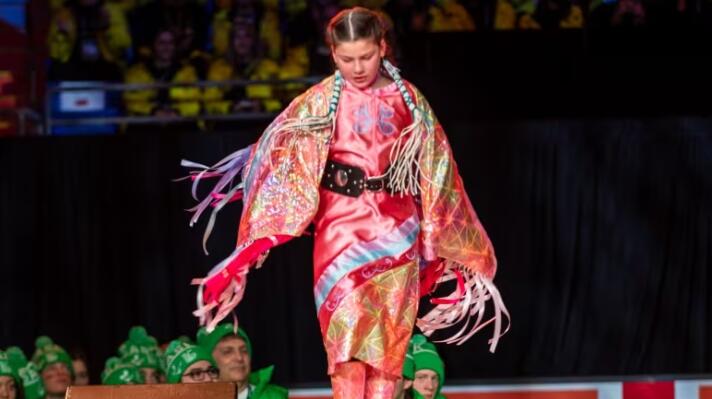Bravery was my children performing the Mi’kmaq Ko’jua dance at the Canada Games

Their vulnerable presence up on that stage highlighted the power that comes from within
When I was growing up, I didn’t see Indigenous performers or dancers in our local venues. I didn’t see stories of them sharing our culture in the media. I didn’t see them included in celebratory ceremonies. I didn’t see myself represented. In fact, I didn’t see any signs of our culture displayed anywhere.
So when my children were asked to participate in the 2023 Canada Winter Games opening ceremony on P.E.I., we saw it as an opportunity not only to share our culture with others, but also for other Indigenous people to see themselves reflected in the ceremonies and performances.
- CBC P.E.I. First Person FAQ
-
OPINION
Ending systemic racism isn’t just about institutional reform — it starts with us
Now nine and 11, my kids have been performing with the Mi’kmaq Heritage Actors for years and dancing at mawiomis (gatherings) since they could walk. But seeing them at the Games making connections with people from across Canada — showcasing our culture through song and dance — is an experience I’ll never forget.
The kids had prepared for the crowd at the opening ceremony, but the reality was something else altogether. The cheering, the noisemakers, the clapping coming from thousands of people was overwhelming to say the least. Just before it was time to go on stage, nerves got the better of both kids — and the fear of performing for such a large crowd started to take over.
Show time
My daughter, Taya, was so terrified of crying on stage that she told me she didn’t want to perform at all.
“It’s fine if you cry on the stage,” I told her. “We are all human. We all have emotions and you are here to dance and share your culture with others. Just do the best you can.”
With lots of hugs, deep breaths, words of encouragement and support from the stage manager Sylvia, Taya made her way on stage and tried to hold it together. An Alberta coach who saw Taya struggling promised to give her his team Alberta tuque.
Eventually I watched both of my kids — filled with fear and trepidation — walk onto that big stage and comfort each other with pats on the back, head nods and a few kind words. There were a few tears shed on that stage, but the show went on, and they danced.
-
OPINION
Stop asking Black people to perform emotional labour during Black History Month
-
FIRST PERSON
Why it’s important for Indigenous people to tell our own stories
As soon as the drum started, they both put on their game faces. It was show time with a dance they had done hundreds of times: the traditional Mi’kmaq Ko’jua dance where they start with their feet in a V formation and tap one heel three times, then do the same thing with the other foot. Once they got into it, they added their arms and got into the rhythm. It’s a joyful dance connected to our ancestors.
The fringes of my son’s grass dance regalia swished back and forth as Taite danced. His porcupine head roach swayed with the movement. I heard the bells on his feet hit every beat perfectly. The bright colours on his regalia shone in the spotlight. Taya’s fancy shawl moved as gracefully as she did, glimmering under the lights surrounded on all sides by the thousands of people in the crowd. Their vulnerable presence up on that stage highlighted the power that comes from within.
I greeted them with open arms and tight hugs when they finished their performance. And there was that coach from Alberta, waiting to hand over his tuque. Taya wore it almost every day during the two weeks of the Canada Games.

This is what bravery looks like
Over the two weeks the Canada Games were on the Island, Taite and Taya were recognized everywhere they went. Athletes wanted photos with them, and so many people — from volunteers to coaches to athletes — expressed how much the performance meant to them and how it impacted them. With every connection made, the kids beamed with pride as they talked about their performance and the magnitude of taking the stage at such a huge venue.
Taite and Taya were invited back for the closing ceremony and they were better equipped with what to expect this time around. There were no tears — just lots of talking, laughter, dancing and smiles. They walked out into the arena with confidence — Taite waving the Mi’kmaq flag and Taya fancy shawl dancing to the Mawiomi song sung by the Mi’kmaq Heritage Actors.
I can’t put into words the amount of pride I felt watching those two young Mi’kmaw youth showcase their culture for thousands to see across Canada — and the pride they felt for themselves having accomplished such a task.
Related News
Trade war, slumping border traffic: What does that mean for the Gordie Howe bridge?
Amid U.S. President Donald Trump’s tariffs which have triggered a trade war with Canada, cross-border trips haveRead more
Trump administration threatens Harvard’s foreign enrolment, tax-exempt status
U.S. Homeland Security Secretary Kristi Noem speaks during an event on April 9, in Washington,Read more
